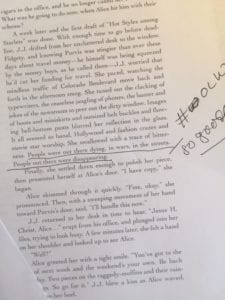Inside the Industry: The Wonderful World of Galleys
Joanna Biggar's new book has just gone to galley, but what does that mean?

A galley, put simply, is a proofing copy. Doggy-eared, coffee-stained, and scribbled on with bright red pen, the galley is the penultimate stage before publication where all the smallest details of a manuscript, disregarded during the writing and organizing process, are scrutinized by fastidious copy-editors and a team of eager-to-help friends of the author. Because it is designed to facilitate the proof-reading and editing process, the galley often looks quite different from the version which goes to print. For example: so the copy-editor has space to curate with her pen, the margins of a galley proof are quite large. The design flare is also cut down, the book taking on a minimalist aspect, much like how a screen play might look, prioritizing white-space and simple font sets.

Historically, the “galley” referred to a part of the European printing press championed by goldsmith Johannes Guttenberg. "Galleys" were metal trays where the type molds were laid in preparation for printing. Several proofing copies would be pressed for early copy-editors to check, and the type would be rearranged accordingly, re-pressed, and re-proofed. When we refer to galleys now, we reference this double-checking of the typeset on the early, manual machines of publishing.
The galley proof may be the first tangible sign of collaboration in publishing. If the author had not yet worked with her editor, the galley may even mark the first instance of compromise and comradeship in the editing and artistic processes. For, an author relinquishing control of the red pen in an official capacity marks a commitment to the publishing process, something we believe fosters creativity. ASP prides itself on the care with which we edit, such care being the product of the work and love of our entire team. Nita Congress is our main copy-editor, though many many eyes pass over the galley and many many different shades of red ramify through the pages before all is said and done.
Galley editing is a tedious task for sure, but so is publishing. And it is precisely the type of tedium from which we fashion and foster excellence in the process and the design. The same sedulity in copy-editing can be seen in formatting, in aesthetic considerations, in the weight of the paper, and, of course, in the writing. The publishing process is not just the kiln which solidifies an idea between hard covers but that which shapes, economizes, and embellishes.
Bound Galleys (ARCs)
After the galleys are assayed and corrected, the next step is the “bound galley” or ARC which stands for “Advanced Reader Copy.” The book at this stage is nearly complete, but the ARC is still not the finished product with all its flare and feel as it, like the proofing galley, opts for a more minimalist presentation. Though, the minimalism of the ARC is utilized to highlight the writing as it is, rather than for corrective purposes. ARC copies are for early reviewers who are concerned with the substance of the art in words. That is, ARCs do not have to worry about catching the attention of a casual browser and so can afford to serve the story a la carte.

Generally, ARC copies are given out for free at either the request of a reviewer (a reviewer can be anyone from a blogger, to a social media personality, to one who writes bi-weekly for the Post) or sent by a publisher singling out a reviewer whom they think might take to the book.
ARCs are a great way to generate buzz about an upcoming title, especially for smaller presses who, if they were to simply release the book without any advanced reviews, would find themselves without the capital for major ad campaigns and entirely subjugated by the first couple of reactions to appear in the wake of the release no matter if they are from Amazon reviewers or the editors of The New Yorker.
Now that we have a set date for the release of the book (OCT 1st, 2019) the next step after sending out the ARCs is a final bit of collaboration and last minute beautifying. As much as a book is the writing, often times the experience of reading is guided by the look and feel of what you have in your hands. This is the focus leading up to the release of Melanie’s Song, Navigating the Divide, Scattered Clouds, and any other book ASP ever puts out. We want it to feel like an ASP book.
More updates to come on all our titles very soon.
Cheers from ASP.